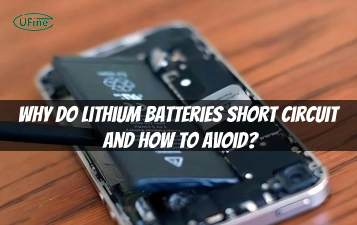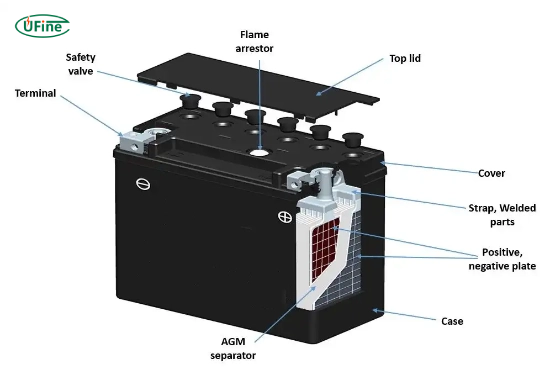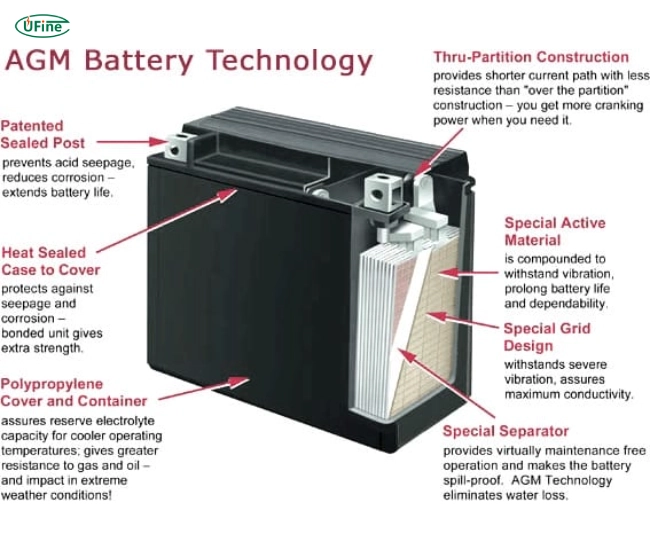
- Part 1. What is an AGM battery?
- Part 2. Why is it important to know if a battery is AGM?
- Part 3. How to identify if a battery is AGM?
- Part 4. How do AGM batteries differ from other types of batteries?
- Part 5. Benefits of AGM batteries
- Part 6. Common signs your battery is AGM
- Part 7. How to properly maintain an AGM battery?
- Part 8. Can you use a regular charger with an AGM battery?
- Part 9. How to choose the right AGM battery?
- Part 10. FAQs
Batteries are crucial in powering our vehicles, gadgets, and other essential devices. However, not all batteries are created equal. AGM (Absorbent Glass Mat) batteries have become increasingly popular due to their reliability, efficiency, and maintenance-free design. But how do you tell if a battery is AGM? This guide will walk you through everything you need to know about identifying AGM batteries, their unique features, and why they stand out from traditional battery types. Let’s dive in!
Part 1. What is an AGM battery?
AGM (Absorbent Glass Mat) batteries are a type of lead-acid battery designed with advanced technology to provide better performance, durability, and efficiency. Unlike traditional flooded lead-acid batteries, AGM batteries use a fiberglass mat to hold the electrolyte, preventing it from spilling. This design makes them maintenance-free and highly resistant to vibration, making them ideal for various applications, including vehicles, boats, and renewable energy systems.
People often call AGM batteries ‘sealed lead-acid batteries’ because they are sealed, meaning you don’t need to add water or perform regular maintenance.
Part 2. Why is it important to know if a battery is AGM?
Understanding whether your battery is AGM is essential for several reasons:
- Proper Charging: AGM batteries require specific charging voltages and settings. Using incorrect chargers can damage the battery and reduce its lifespan.
- Maintenance-Free Benefits: Knowing your battery type ensures you don’t waste time attempting unnecessary maintenance.
- Performance Optimization: AGM batteries deliver consistent power and perform better under extreme conditions. Leveraging these benefits requires recognizing your battery type.
- Safety: AGM batteries are spill-proof and safer to handle than traditional flooded batteries.
Part 3. How to identify if a battery is AGM?
Identifying if a battery is AGM can be straightforward if you know what to look for. Here are the key steps and indicators:
1. Check the label or markings
The easiest way to determine if your battery is AGM is by inspecting the label or specifications printed on the battery case. Look for any of the following terms:
- “AGM” or “Absorbent Glass Mat”
- “Sealed Lead Acid”
- “Valve Regulated Lead Acid” (VRLA)
If these terms are present, your battery is likely an AGM type.
2. Observe the design
AGM batteries have a sealed, maintenance-free design. Unlike traditional flooded batteries, they don’t have removable caps for adding water. The absence of vent caps or openings indicates that the battery is AGM.
3. Look for spill-proof or vibration-resistant features
Manufacturers design AGM batteries to be spill-proof and resistant to vibrations. If a manufacturer markets a battery as non-spillable or suitable for harsh environments, it’s likely an AGM battery.
4. Test the battery’s weight
Due to their denser construction, AGM batteries are generally heavier than standard flooded lead-acid batteries. While this isn’t a foolproof method, weight can provide a clue.
5. Consult the user manual or manufacturer
If unsure, refer to the user manual or contact the manufacturer. They can provide detailed information about your battery type.
Part 4. How do AGM batteries differ from other types of batteries?
It is crucial to identify the differences between AGM batteries and other types. Here’s how AGM batteries compare to other common battery types:
1. AGM vs. Flooded Lead-Acid Batteries
- Electrolyte: AGM batteries use an absorbent glass mat to hold the electrolyte, while flooded batteries have liquid electrolytes that can spill.
- Maintenance: AGM batteries are maintenance-free, while flooded batteries require regular water refills.
- Design: AGM batteries have seals, whereas flooded batteries use vent caps.
2. AGM vs. Gel Batteries
- Electrolyte Consistency: Gel batteries use a gel-like electrolyte, while AGM batteries use a fiberglass mat.
- Performance: AGM batteries are better for high-power applications, whereas gel batteries perform better in deep-cycle scenarios.
3. AGM vs. Lithium-Ion Batteries
- Technology: AGM batteries are lead-acid based, while lithium-ion batteries use lithium compounds.
- Lifespan: Lithium-ion batteries typically last longer but are more expensive.
- Applications: AGM batteries are ideal for vehicles and backup power, while people use lithium-ion batteries in portable electronics and electric vehicles.
Part 5. Benefits of AGM batteries
Choosing an AGM battery comes with several advantages, including:
- Maintenance-Free Operation: No need to add water or monitor electrolyte levels.
- Spill-Proof Design: Safe to use in various orientations without the risk of leaks.
- Durability: AGM batteries resist vibrations and shocks, making them ideal for off-road vehicles and boats.
- Faster Charging: AGM batteries charge more quickly than traditional lead-acid batteries.
- Longer Lifespan: With proper care, AGM batteries last longer than flooded batteries.
- Consistent Performance: They deliver reliable power even in extreme temperatures.
Part 6. Common signs your battery is AGM
If you’re still unsure whether your battery is AGM, here are some common signs to look for:
- The battery case is labeled as “sealed” or “maintenance-free.”
- The battery is heavier than a standard flooded battery of the same size.
- There are no removable caps for adding water.
- The manufacturer advertises the battery as spill-proof or vibration-resistant.
- The manufacturer specifies that the battery is AGM in the manual or documentation.
Part 7. How to properly maintain an AGM battery?
Although AGM batteries are low-maintenance, proper care can extend their lifespan and ensure optimal performance. Here are some tips:
- Use the correct charger: AGM batteries require chargers explicitly designed for their technology. Avoid overcharging or undercharging.
- Avoid deep discharges: While AGM batteries can handle deep discharges better than other types, frequent deep cycling can shorten their lifespan.
- Store properly: If you’re storing your AGM battery for an extended period, keep it in a cool, dry place and periodically charge it to prevent discharge.
- Inspect for damage: Regularly check for any signs of physical damage or corrosion.
Part 8. Can you use a regular charger with an AGM battery?
No, you should not use a regular charger with an AGM battery unless it is specifically compatible with AGM technology. Standard chargers may apply incorrect voltage levels, which can overcharge or damage the battery. Instead, opt for a smart charger or one with an AGM setting to ensure safe and efficient charging.
Part 9. How to choose the right AGM battery?
When selecting an AGM battery, consider the following factors:
- Capacity (Ah): Choose a battery with sufficient capacity.
- Size: Ensure the battery fits in the designated space.
- Brand Reputation: Opt for trusted brands with positive reviews.
- Application: Select a battery designed for your specific application, such as automotive, marine, or solar.
Considering these factors, you’ll find the perfect AGM battery for your requirements.
Part 10. FAQs
-
How can I tell if my car battery is AGM?
Check the label or user manual of your battery. If it mentions “AGM,” “Absorbent Glass Mat,” or “Valve Regulated Lead Acid,” it’s an AGM battery. -
Are AGM batteries better than regular batteries?
Yes, AGM batteries offer several advantages, including maintenance-free operation, spill-proof design, and better resistance to vibrations. However, they are generally more expensive. -
Can I replace a flooded battery with an AGM battery?
Yes, AGM batteries can replace flooded batteries in most applications, but ensure your charging system is compatible with AGM technology. -
How long do AGM batteries last?
AGM batteries can last 4-7 years with proper care, depending on usage and conditions. -
Are AGM batteries good for cold climates?
AGM batteries perform well in cold climates, delivering consistent power in low temperatures.
Related Tags:
More Articles

What Is the Lithium Battery Short Circuit?
What is the lithium battery short circuit? To understand a lithium battery short circuit, we first need to understand how the battery works.
How to Distinguish Battery Cells, Battery Modules, And Battery Packs?
Discover how battery cells, modules, and packs work, their engineering roles, and practical guidance for safe and efficient design.
What is the Difference Between Silver Zinc Battery vs. Lithium-ion Rechargeable?
Compare silver zinc and lithium-ion rechargeable batteries: energy density, cycle life, safety, cost, and uses in drones, medical devices, EVs, and electronics.
What are Watts and Watt Hours in Battery?
Understand watt vs watt-hour in batteries: key differences, how to calculate capacity, and why they matter. Includes free comparison table.
Best 10 Blood Pressure Monitor Battery Review: Finding the Most Reliable
Are you looking for a reliable Blood Pressure Monitor battery? Here is a complete guide with the top 10 best blood pressure monitor batteries.




